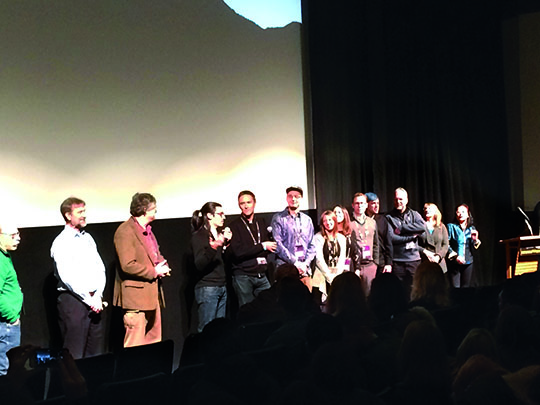Chasing coral and fighting global warming

The production team of Chasing Coral receives a standing ovation at the Sundance Film Festival.
As the winner of the audience award for Best U.S. Documentary at the Sundance Film Festival, Chasing Coral offers a unique look into the diminishing world of coral reefs around the world. When underwater photographer Richard Vevers was out diving at one of his favorite reefs, he noticed a phenomenon he had not yet encountered. The colorful corals he was used to taking pictures of had started to turn into white, skeleton-like structures. Upon further investigation, he realized that his precious corals were the victims of the phenomena, coral bleaching.
Coral bleaching occurs when there is a significant rise in temperature in the ocean. Corals have a symbiotic relationship with and algae called zooxanthellae that actually lives in the coral’s tissue. These algae are the coral’s primary food source and is what gives the coral its beautiful color. When the water temperature rises significantly, the algae become stressed and eventually leaves the coral, causing the coral to die without an energy source.
According to a Catlin Seaview Survey, half of the earth’s coral reefs have disappeared in the last three decades. The temperature in the ocean is directly correlated to the median temperature of the earth, and if the earth’s temperature keeps rising because of carbon emissions and global warming, so will the ocean temperature.
Vevers wanted to take action, so he teamed up with director Jeff Orlowski to make a film that would help spread the word about what is going on under the surface of our oceans.
Vevers and Orlowski wanted to do time lapse photography of the coral during a bleaching event.
The only problem was that no one had ever done time lapse photography under water before and there was not equipment designed for it.
Vevers and Orlowski designed a brand-new fitting for underwater cameras, a sort of dome with an automatic windshield wiper to remove algae and other particles that might stick to the glass; however, getting the cameras to take pictures in focus day after day proved to be almost impossible, and the first attempts at recording the event failed.
In the end, they were forced to take the pictures manually. Divers took hundreds of photographs day after day, in the exact same spots to create the stunning time lapses that the documentary ends with and leaves the viewers stunned.
Chasing Coral is both a visually stunning documentary and a cry for help. Vevers, Orlowski and the rest of the cast are practically begging people around the world to wake up and do something about carbon emissions so that we might save what is left of the earth coral reefs.
With the help of passionate cast and crew members, Orlowski manages to turn a highly scientific documentary into an emotional and visual rollercoaster ride that no one should miss.
Follow the team’s work at https://www.exposurelabs.com/










